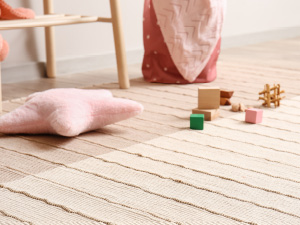Synthetic Carpet Fibers
Carpet and area rugs can enhance the décor of any space, but not all floor covering is made the same. Carpet and area rug materials generally fall into 2 different categories: natural fiber and synthetic fiber. They each have their pros and cons. Make sure you get the one that is right for your needs. Here we will explore synthetic floor covering.
What is synthetic carpet fiber?
Synthetic carpet fiber is created in a man-made manufacturing process. It is not as eco-friendly as natural fiber in either its creation or the manufacturing process. Synthetic carpet makes up the biggest percentage of wall-to-wall carpeting. It is much more stain and mold resistant than natural fiber carpet, making it great for both offices and homes.
What types of synthetic fiber are used in carpet?
There are 4 main types of synthetic fiber for carpets and rugs: Nylon, Polyester, Olefin and Triexta.
Nylon
Nylon is the most well known of the synthetic fiber carpets. It’s strong and resists “crushing,” making it great for high traffic areas. Nylon does have staining issues, but that can be minimized by making sure it is protected with a stain treatment. Most nylon carpeting is pretreated with stain protection, but it never hurts to double check. Nylon is great for wall-to-wall projects.
Polyester
Polyester has gotten a bad reputation in the past for not being as durable or strong as nylon, but with the advent of new technology, polyester is making great strides in that area. Polyester also has better stain resistance than nylon. Some polyester carpeting is now made with recycled material, making it a bit more eco-friendly to make, but the actual carpet itself is not recyclable. Polyester tends to have a lower price point than nylon. It does resist fading and is softer than its nylon counterpart. It is great for wall-to-wall applications.
Olefin
Olefin has a look that is similar to wool, in a manmade sort of way. As synthetics go, Olefin is considered to be inferior, as far as strength and durability are concerned. Consequently, it is considered by many to be a contractor- grade item. Before you decide against it, it should be mentioned that Olefin is good in low-traffic areas, and it is very fade and stain resistant. Olefin does not absorb liquid, making spill cleanup much easier. Possible uses would be a guest room, outdoor carpet, or basements. It is generally not recommended for wall-to-wall projects in high traffic rooms.
Triexta
Triexta has been around for just a little over a decade. It is a relative newcomer to an industry that has been around for eons. Although similar to polyester, it is softer and resists crushing better than polyester. Triexta is resistant to staining, and most water-based spills can be taken care of with cold water. Even though it is a synthetic fiber, part of the manufacturing process uses corn glucose (sugar), making it just a bit more on the eco-friendly side. The biggest drawback to Triexta is that it is relatively new on the market, and its longevity, while looking promising, is unknown at this time.
Off-gassing
All synthetic carpet off-gasses when first installed, which means that your new carpet may smell when you first get it. The smell will go away in a few days to a week. (Triexta gives off less smell due to being partially made with corn glucose.) Off-gassing shouldn’t be a reason to not get synthetic carpet. Lots of other things off-gas such as: cabinets, new furniture, cleaners, cosmetics, and a host of other items.
Carpets and area rugs can be a big investment. If you are interested in a particular material, make sure you are clear on the pros and cons of each type so that you find the floor covering that is perfect for you, your budget, and your home.
By Sharon Koehler. This article is one of a series of articles written and published on behalf of Surface Care PRO Partners.

